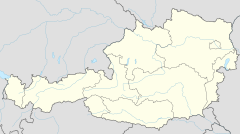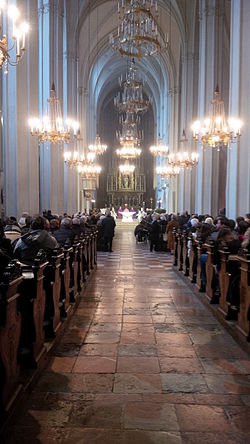
St. Stephen's Cathedral is a Roman Catholic church in Vienna, Austria, and the mother church of the Archdiocese of Vienna. It is the seat of the Archbishop of Vienna, Christoph Schönborn.

The Imperial Crypt, also called the Capuchin Crypt (Kapuzinergruft), is a burial chamber beneath the Capuchin Church and monastery in Vienna, Austria. It was founded in 1618 and dedicated in 1632, and located on the Neuer Markt square of the Innere Stadt, near the Hofburg Palace. Since 1633, the Imperial Crypt serves as the principal place of entombment for the members of the House of Habsburg. The bones of 145 Habsburg royalty, plus urns containing the hearts or cremated remains of four others, are here, including 12 emperors and 18 empresses. The visible 107 metal sarcophagi and five heart urns range in style from puritan plain to exuberant rococo. Some of the dozen resident Capuchin friars continue their customary role as the guardians and caretakers of the crypt, along with their other pastoral work in Vienna. The most recent entombment was in 2023.
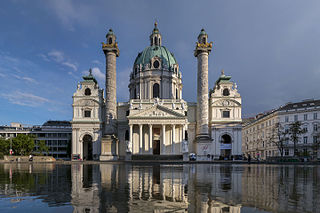
The Rektoratskirche St. Karl Borromäus, commonly called the Karlskirche, is a Baroque church located on the south side of Karlsplatz in Vienna, Austria. Widely considered the most outstanding baroque church in Vienna, as well as one of the city's greatest buildings, the church is dedicated to Saint Charles Borromeo, one of the great counter-reformers of the sixteenth century.

Eleonora Gonzaga, was born a princess of Mantua as a member of the House of Gonzaga, and by marriage to Ferdinand II, Holy Roman Emperor, was Holy Roman Empress, German Queen, Queen of Hungary and Bohemia.
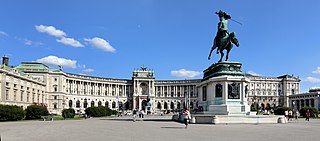
The Hofburg is the former principal imperial palace of the Habsburg dynasty in Austria. Located in the centre of Vienna, it was built in the 13th century and expanded several times afterwards. It also served as the imperial winter residence, as Schönbrunn Palace was the summer residence. Since 1946, it has been the official residence and workplace of the president of Austria.

The Votivkirche is a neo-Gothic style church located on the Ringstraße in Vienna, Austria. Following the attempted assassination of Emperor Franz Joseph in 1853, the Emperor's brother Archduke Ferdinand Maximilian inaugurated a campaign to create a church to thank God for saving the Emperor's life. Funds for construction were solicited from throughout the Empire. The church was dedicated in 1879 on the silver anniversary of Emperor Franz Joseph and his wife Empress Elisabeth.

St. Rupert's Church is a Romanesque church in Vienna, Austria. Traditionally considered to be the oldest church in the city, St. Rupert's Church is dedicated to Saint Rupert of Salzburg, patron saint of the salt merchants of Vienna. The church is located in one of the oldest parts of the city, the section of the Roman Vindobona.
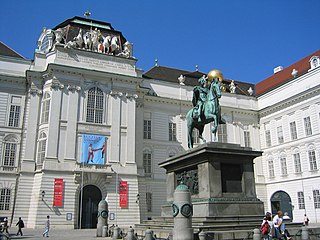
Josefsplatz is a public square located at the Hofburg Palace in Vienna, Austria. Named after Emperor Joseph II, Josefsplatz is considered one of the finest courtyards in Vienna.

Prince Albert Casimir of Saxony, Duke of Teschen was a Saxon prince from the House of Wettin who married into the Habsburg imperial family. He was noted as an art collector and founded the Albertina in Vienna, one of the largest and finest collections of old master prints and drawings in the world.

The Herzgruft is a burial chamber that protects 54 urns containing the hearts of members of the House of Habsburg. The crypt is located behind the Loreto Chapel in the Augustinian Church within the Hofburg Palace complex in Vienna, Austria.

The Ducal Crypt is a burial chamber beneath the chancel of Stephansdom in Vienna, Austria. It holds 78 containers with the bodies, hearts, or viscera of 72 members of the House of Habsburg.

Maria am Gestade is a Gothic church in Vienna, Austria. One of the oldest churches in the city—along with St. Peter's Church and St. Rupert's Church—it is one of the few surviving examples of Gothic architecture in Vienna. Located in the Innere Stadt at Salvatorgasse 12, near the Donaukanal, the church was traditionally used by sailors on the Danube river. The name reflects the former location on the Fluvial terrace of an arm of the Danube river, prior to its regulation.
Due to the stairs surrounding the church it got the popular name Maria Stiegen.
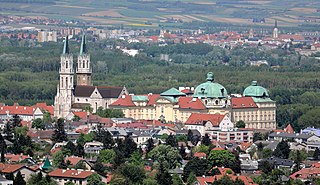
Klosterneuburg Abbey or Monastery is a twelfth-century Augustinian monastery of the Catholic Church located in the town of Klosterneuburg in Lower Austria. Overlooking the Danube, just north of the Vienna city limits at the Leopoldsberg, the monastery was founded in 1114 by Saint Leopold III of Babenberg, the patron saint of Austria, and his second wife Agnes of Germany.

Saint Michael's Church is one of the oldest churches in Vienna, Austria, and also one of its few remaining Romanesque buildings. Dedicated to the Archangel Michael, St. Michael's Church is located at Michaelerplatz across from St. Michael's Gate at the Hofburg Palace. St. Michael's used to be the parish church of the Imperial Court, when it was called Zum heiligen Michael.

The Hofkirche is a Gothic church located in the Altstadt section of Innsbruck, Austria. The church was built in 1553 by Emperor Ferdinand I (1503–1564) as a memorial to his grandfather Emperor Maximilian I (1459–1519), whose cenotaph within boasts a remarkable collection of German Renaissance sculpture. The church also contains the tomb of Andreas Hofer, Tyrol's national hero.

Archduchess Mathilde Marie Adelgunde Alexandra of Austria was a member of the House of Habsburg-Lorraine as the daughter of Archduke Albert, Duke of Teschen. She was intended to become the Queen of Italy as the wife of King Umberto I, but her early death prevented the marriage.
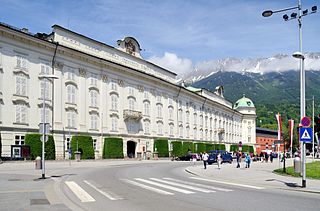
The Hofburg is a former Habsburg palace in Innsbruck, Austria, and considered one of the three most significant cultural buildings in the country, along with the Hofburg Palace and Schönbrunn Palace in Vienna. The Hofburg is the main building of a large residential complex once used by the Habsburgs that still includes the Noblewomen's Collegiate Foundation, the Silver Chapel, the Hofkirche containing Emperor Maximilian's cenotaph and the Schwarzen Mandern, the Theological University, the Tyrolean Folk Art Museum, Innsbruck Cathedral, the Congress, and the Hofgarten.

Augustinerkirche was once one of the five main churches in the old town of Zürich, Switzerland, together with Fraumünster, Grossmünster, Predigern and St. Peter's. First built around 1270 as a Romanesque church belonging to the Augustinian abbey, on occasion of the Reformation in Zürich worship in the church was discontinued. The present Christian Catholic Church community of Zürich planned to rebuild the building to commemorate the old Augustinian church, and for the same reason, Augustinerkirche is still their Parish church, that was rebuilt in 1843/44 by Ferdinand Stadler. In the late 1950s, the church was rebuilt in accordance with the plans for the original structure. Today the building is one of the three medieval churches in the Lindenhof district of the city of Zürich.
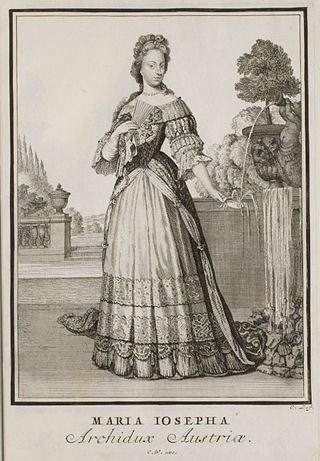
Maria Josepha of Austria was the penultimate child of Leopold I, Holy Roman Emperor and his third wife, Princess Eleonore Magdalene of Pfalz-Neuburg.
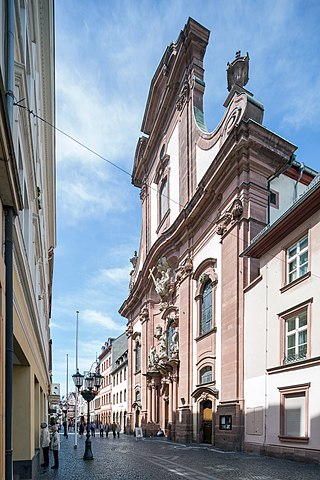
The church of St. Augustin known in German as Augustinerkirche, was the minster of the Augustine friars in the city centre of Mainz. Today it is the seminary church of the Catholic theological seminary of the Roman Catholic Diocese of Mainz.

